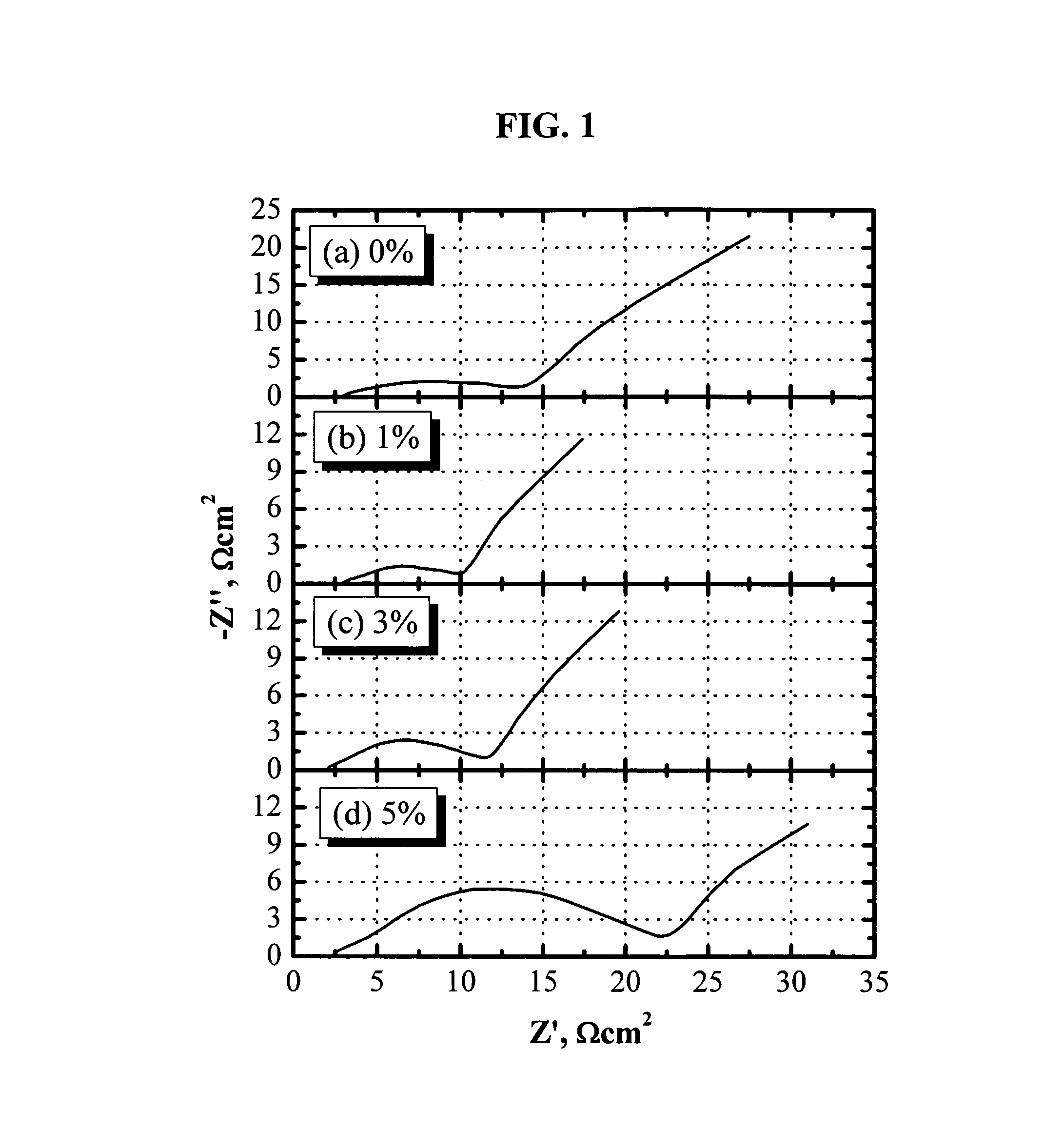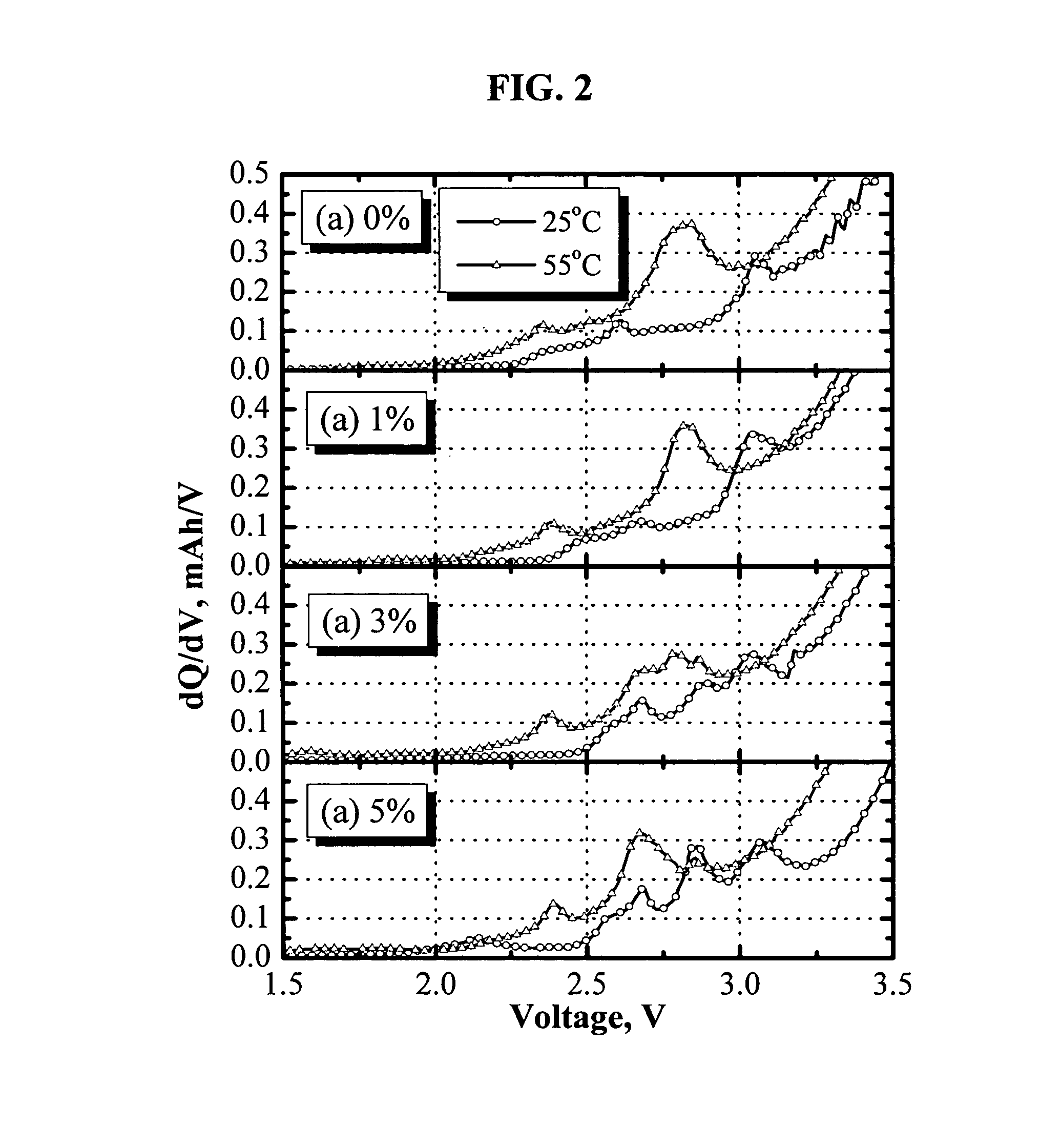Non-aqueous electrolytes for lithium ion batteries
a lithium ion battery and non-aqueous electrolyte technology, which is applied in the direction of secondary cell servicing/maintenance, cell components, cell component details, etc., can solve the problems of reducing the overall impedance of lithium-ion batteries or batteries, and achieves low impedance, good conductivity, and high power
- Summary
- Abstract
- Description
- Claims
- Application Information
AI Technical Summary
Benefits of technology
Problems solved by technology
Method used
Image
Examples
example 1
[0082]FIG. 1 shows the AC impedance of lithium-ion cells comprising a LiNi1 / 3Co1 / 3Mn1 / 3O2 cathode, soft carbon-coated natural graphite (GDR) anode, and an electrolyte of 1.2 M LiPF6 in EC / PC / DMC (1:1:3 by weight). The AC impedance data were collected after the formation cycles and the cell being constant-voltage charged to 3.97 V (60% SOC). One wt % tris(pentafluorophenyl)borane (0.02 M) is enough to help dissolve the LiF in the passivation films and significantly reduce the cell impedance. When more than 1 wt % tris(pentafluorophenyl)borane was added, the cell impedance increased with the concentration of anion receptor dramatically, although the conductivity of the electrolyte was expected to decrease. When 5 wt % tris(pentafluorophenyl)borane was added, the cell impedance increased so dramatically that it was even higher than that without the anion receptor. Based on these results, cells based on previous patents (U.S. Pat. Nos. 5,849,432, 6,352,798, and 6,022,643), where more th...
example 2
[0083]FIG. 2 shows the differential capacity profile of LiNi1 / 3Co1 / 3Mn1 / 3O2 / / GDR cells during the initial charging step. Several peaks under 3.0 V were attributed to the electrochemical reactions during the formation of a solid electrolyte interphase (SEI). Apparently, addition of 1 wt % tris(pentafluorophenyl)borane has almost no significant impact on the formation of the SEI layer except that it helps to dissolve LiF from the passivation film, which is not an electrochemical process. However, a dramatic change on the differential capacity profile was observed when more than 3 wt % tris(pentafluorophenyl)borane was added. The change of the dQ / dV profile is a clear evidence that the anion receptor, tris(pentafluorophenyl)borane, participates in the formation of the SEI layer and can be related to the increasing cell impedance as shown in FIG. 1.
example 3
[0084]FIGS. 3 and 4 show the results of hybrid pulse power characteristics tests on LiNi1 / 3Co1 / 3Mn1 / 3O2 / / 1.2 M LiPF6 in EC / PC / DMC (1:1:3) / / GDR cells incorporating different amounts of the anion receptor, tris(pentafluorophenyl)borane. The pulse current during the test is at a 5 C rate. The results shown in FIGS. 3 and 4 are consistent with those shown in FIGS. 1 and 2. Clearly, the cell incorporating 1 wt % tris(pentafluorophenyl)borane has the lowest ASI and the highest power capability. In fact, the ASI of the cell with 1 wt % tris(pentafluorophenyl)borane has already exceeded the power requirement for hybrid electric vehicle (HEV) applications. To meet the power requirement for HEV applications, the battery should have ASI of 35 Ωcm2 or less for an 18-second pulse discharge, and 25 Ωcm2 or less for a 2-second pulse regenerative charge. FIG. 3b shows that the cell ASI is about 15 Ωcm2 and 25 Ωcm2 for a 2-second pulse regeneration and an 18-second pulse discharge, respectively. In ...
PUM
| Property | Measurement | Unit |
|---|---|---|
| temperature | aaaaa | aaaaa |
| temperature | aaaaa | aaaaa |
| voltage | aaaaa | aaaaa |
Abstract
Description
Claims
Application Information
 Login to View More
Login to View More - R&D
- Intellectual Property
- Life Sciences
- Materials
- Tech Scout
- Unparalleled Data Quality
- Higher Quality Content
- 60% Fewer Hallucinations
Browse by: Latest US Patents, China's latest patents, Technical Efficacy Thesaurus, Application Domain, Technology Topic, Popular Technical Reports.
© 2025 PatSnap. All rights reserved.Legal|Privacy policy|Modern Slavery Act Transparency Statement|Sitemap|About US| Contact US: help@patsnap.com



